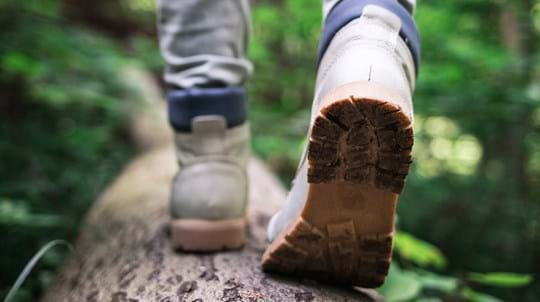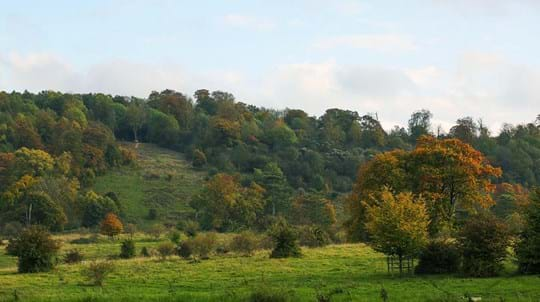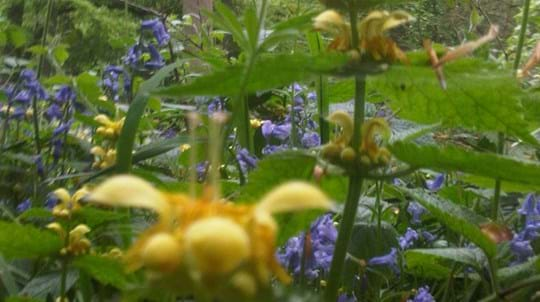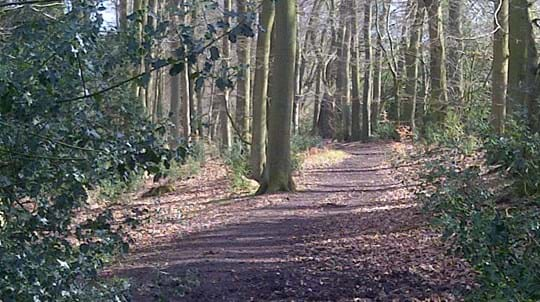
Tring Park
Tring

Woodland Trust wood group
- Tring Park
- Tring Park ext
132.94 ha (328.49 acres)
SP929102
Explorer 181
OS Landranger 165
Walk among mixed broadleaf woodland and explore one of the largest areas of unimproved chalk grassland in the county, designated as a Site of Special Scientific Interest.
This tranquil site park was once part of a sweeping aristocratic estate that was home to the Rothschild family and is just a 10-minute walk from the Natural History Museum at Tring. There are wonderful wildflowers and butterflies to see in spring and summer, historic features, and open vistas with great views.
Before the Rothschilds, the estate was landscaped to create hidden follies and forest gardens, some of which still remain today.
Visit the Tring Park website.
Features
- Parking nearby
- Public access
- Autumn colour
- Spring flowers
- Waymarked walk
- Grassland
- Broadleaved woodland
How to get to Tring Park
Tring Park is a 132.9-hectare (328.5-acre) site to the south of Tring, halfway between Aylesbury and Hemel Hempstead. The site runs along the Chiltern ridge and sits within the Chilterns Area of Outstanding Natural Beauty (AONB). The park and woodland contribute greatly to the local landscape as they are visible from approaches to Tring, notably from the A41.
From the A41, take the A4251 exit to Wigginton, Berkhamsted and Northchurch. At the roundabout, take the first exit onto London Road (B4635) and follow the road for 0.8km (0.5 miles). At the next roundabout, take the second exit onto Brook Street (B488) and continue until you reach Tring. The car park is located next to the Natural History Museum.
Tring railway station is 3.2km (2 miles) away.
Visit National Rail for more information.
There are two bus stops near to the wood. The closest bus stop to the eastern entrance is at the corner of Fox Road and Highfield Road in Wigginton, 200 metres away.
The nearest bus stop to the northern entrance is at the corner of Akeman Street and High Street, 500 metres away.
Visit Traveline for more information.
The towpath of the Grand Union Canal offers a scenic, traffic-free route to Tring Park.
Come off the canal at Station Road and continue towards the High Street (B4635). Follow the brown signage, turning left onto Akeman Street. Continue until you reach the main entrance of the Natural History Museum. Turn left onto Park Street. A small gate on the right hand side of the road takes you to the car park where there are several bike stands.
Please note that King Charles Ride is the only path where cycling is permitted.
Facilities and access
The paths at Tring Park are a variety of surfaces and gradients. The main one through the woodland (King Charles Ride) is also a bridleway and is the only path cyclists and horse riders are permitted on. This path is semi-surfaced and firm under foot.
Other woodland paths are unsurfaced, while those in the parkland are typically grass. All can become extremely muddy and slippery in wet and adverse weather conditions.
The majority of the parkland walks include a relatively steep incline.
There are nine entrances to Tring Park, two of which feature steps and four of which have kissing gates. There are also kissing gates between the parkland and the woodland to prevent the escape of grazing cattle. One gate leading towards the Obelisk has been modified to allow for a mobility scooter.
The free, joint Woodland Trust and Natural History Museum at Tring car park can accommodate 30 cars, with four spaces designated for blue badge holders. These spaces are clearly marked with the blue badge logo. There are no time restrictions on length of parking for visitors to the site, but the car park is closed at 5pm.
The car park is open 10am-5pm Monday to Saturday, 2pm-5pm on Sundays.
This car park can become busy during school holidays. There are alternative car parks in Tring town centre.
The nearest toilets are in the Natural History Museum at Tring which are open from 10am-5pm Monday to Saturday. There are also toilets in Tring Forge car park, including some disabled and baby change facilities. The forge car park is 0.8km (0.5 miles) from the entrance to Tring Park.
Wildlife and habitats
Wildlife
Look and listen for the many fantastic animal species found at Tring Park. As marbled white butterflies flutter around flowers, impressive red kites and long-eared owls swoop over meadows looking for voles, and there’s an unexpected resident too – edible dormice! Walter Rothschild brought the first six to England in 1902 and for some reason set them loose in Tring Park where they spread and bred.
Cattle graze in the main parkland, while sheep can be found on Oddy Hill. Please do not approach or feed the livestock.
Trees, plants and fungi
Tring Park was once part of a larger estate which included Tring House and gardens. Throughout the parkland are the remnants of landscape planting from various periods. These include splendid mature specimens of beech, horse chestnut and lime, along with some stunning, eye-catching copper beech and a regimented square of Scots pine. The park is also home to biologically significant chalk grassland, and meadow, which has spring and summer blooms of cowslips, lady's bedstraw, yellow rattle, saxifrage, and salad burnet, that attract butterflies, birds, and insects.
Habitats
Tring Park contains a mix of habitats such as chalk grassland, scrub, mixed woodland and parkland landscaped by Charles Bridgeman in the late 17th and early 18th centuries. The chalk grassland is the second largest in Hertfordshire and is an extremely rare habitat, hence its designation as a Site of Special Scientific Interest (SSSI).
About Tring Park
Tring Park is brimming with history: from being formed from the limestone of the Chiltern Hills that were created at the end of the last Ice Age 10,000 years ago, to becoming established as a manor site in the Saxon period and playing host to gentry, kings and queens from then on. Royal connections include Charles II’s notorious mistress, Nell Gwyn, to whom the towering obelisk in the park is reputed to commemorate.

Credit: Judith Parry, WTML
Tring Park Mansion
Tring Park was once part of a larger estate which included the stunning Tring Park Mansion, originally designed by Sir Christopher Wren in 1685. Past residents have included Sir William Gore, Sir Drummond Smith and members of the Rothschild family. The mansion is now a school for the performing arts.
The grounds of the mansion and wider estate were formally landscaped in the 1720s by leading landscaper Charles Bridgeman, evidence of which can be seen in the park today.
Walter Rothschild
The Walter Rothschild Zoological Museum, now the Natural History Museum at Tring, was built by Nathan Rothschild for his eldest son, Walter. Walter started to collect stuffed animals when he was just seven years old. He opened his museum to the public in 1892 when he was 24, and it remains one of the largest private natural history collections ever assembled.
In his teens, Walter also started to acquire live exotic animals which were all allowed to roam freely in the park. That is, until his father was chased on his horse by a cassowary, after which some of the animals were caged, with the exception of the emus and rheas.

Your support matters
This wood was secured for the future thanks to your response to an urgent appeal. Discover how you helped us bring another incredible place safely under our wing, and what the future holds for Tring Park.
See what we've achievedThings to do at Tring Park
Walks
A moderate 3.5km/2-mile walk that takes around two hours and includes sight of ancient monuments and the restored Rond Point.
A moderate 2.5km/1.5-mile walk that takes around 45 minutes and includes a stroll through the chalk grasslands.
A moderate 3km/1.9-mile walk that takes approximately 90 minutes and includes stunning views from King Charles Ride. On a clear and crisp winter day, it is possible to see Ivinghoe Beacon.
An easy 1.6km (1 mile) walk that covers a short section of the ridgeway. The trail has a wide, mostly smooth path of compressed chalk that has short, gentle gradient changes. You'll pass along King Charles Ride, with superb views over Ivinghoe Beacon.
Keeping to marked paths helps us care for and protect the parkland and woodland. Visitors and dogs should avoid creating and using ‘desire line’ paths (created when visitors leave the paths provided) that can often disturb ground nesting birds and rare plants. This also helps us to protect the areas where species lay dormant until the spring or summer.
Natural History Museum at Tring
Make a day of it and combine your visit to Tring Park with a trip to the Natural History Museum.
Tring Park’s former resident, Walter Rothschild, bequeathed his zoological collection to the public in 1892. It remains one of the largest private collections of natural history ever assembled.
Cycle the King Charles Ride
Want to cycle through Tring Park? You can on our King Charles Ride, which is also part of the Ridgeway National Trail. The 1.6km (1 mile) stretch of bridleway takes in some magnificent views of the local area and is a fairly flat, wide, semi-natural surfaced path.
As this is the only path that cycling is permitted on in Tring Park, you will need to enter Tring Park from the Marlin Hill entrance.
To find this entrance, start from the Natural History Museum entrance on Akeman Street, follow the sharp right-hand bend and turn immediately left onto Hastoe Lane. Continue for around 0.8km (0.5 miles) and bear left onto Marlin Hill for another 0.8km. The entrance to Tring Park is on the left-hand side of the road.
Six bike stands are available next to the coach parking bays. Please take care when cycling on this path as it’s also used by walkers and horse riders.
Horse riding
Take a horse ride around Tring Park, taking in the sights and sounds while sticking to the designated bridleway. Be aware that cyclists and walkers also use this route.

Take an audio tour of this wood
Listen to our Woodland Walks podcast series with host Adam Shaw and special guests.
External link

Visiting woods
Walking dogs in our woods
Dogs are welcome for walkies in our woods. Take a look at our tips and guidelines for ensuring we keep our woods safe and special for dogs and wildlife.

360 tour
Take a tour of Tring Park
Discover the sights and sounds of Tring Park with 12 different 360 images to explore.
External link

Visiting woods
Events
Discover events at our woods and the festivals and fairs you can find us at soon.










































